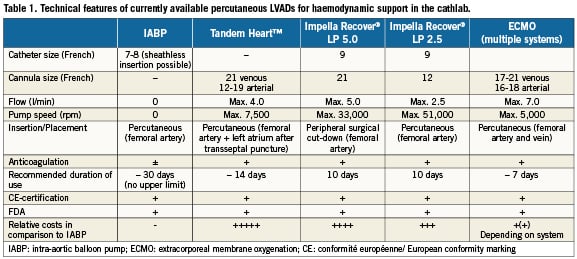In this chapter of Tools and Techniques the use of percutaneous left ventricular assist devices is discussed using a step-wise approach. The following is an overview with highlights on specific technical issues. The complete, unabridged e-version with images is available at www.eurointervention.org.
Background
Percutaneous insertable devices such as the intra-aortic balloon pump (IABP) or active left ventricular assist devices (LVAD) are currently mainly used for additional treatment in haemodynamically unstable patients in cardiogenic shock, as well as for selected patients undergoing high-risk percutaneous coronary interventions (PCI). Mainly due to the lack of sufficient scientific evidence, there are wide variations in the use of the different available devices.
Indications
In addition to PCI, inotropes, and fluids, IABP or LVADs are the most widely accepted indication for initial haemodynamic stabilisation in cardiogenic shock complicating acute myocardial infarction. The main limitation of IABP is the lack of active circulatory support and the requirement of a certain level of left ventricular function which often leads to insufficient reversal of cardiogenic shock. The use of percutaneous LVADs with active circulatory support is therefore considered as staged or initial therapy in patients not responding to standard treatment including IABP support. The use of IABP or LVADs is more controversial in patients with high-risk PCI features.
Difficulties
There are several different devices available which are approved for the market, and usually not all devices available are familiar to each interventional cardiologist (Figure 1). Some of the devices need a certain level of expertise in implantation techniques as well as in understanding their specific mode-of-action. In addition, specific complications may arise from the different devices. However, the major difficulty is currently the limited evidence for any of these devices and the differential indication.

Figure 1. Overview of the different devices for percutaneous haemodynamic support A: IABP; B: TandemHeart™; C: Impella Recover® LP 2.5; D: ECMO
Methods
This article reviews the current experience of the IABP as well as other currently available percutaneous LVADs for the treatment of cardiogenic shock and/or high-risk PCI (Table1). First the mode-of-action of the different devices is described, and then the implantation procedure is described. In addition, the current evidence is summarised and potential indications for a preferred treatment are suggested (Figure 2). Finally, typical complications of each of the devices are described.


Figure 2. Potential treatment algorithm and use of IABP and LVAD as a staged therapy.
Conflict of interest statement
H.Thiele has received research funding from Maquet Cardiovascular, Germany as well as Teleflex Medical, USA; is a consultant for Maquet Cardiovascular, Germany and has received speaker honoraria from Maquet Cardiovascular, Germany. G.Schuler is a consultant for Maquet Cardiovascular, Germany. None of the other authors (GF and JF) have any conflicts of interest to declare.

